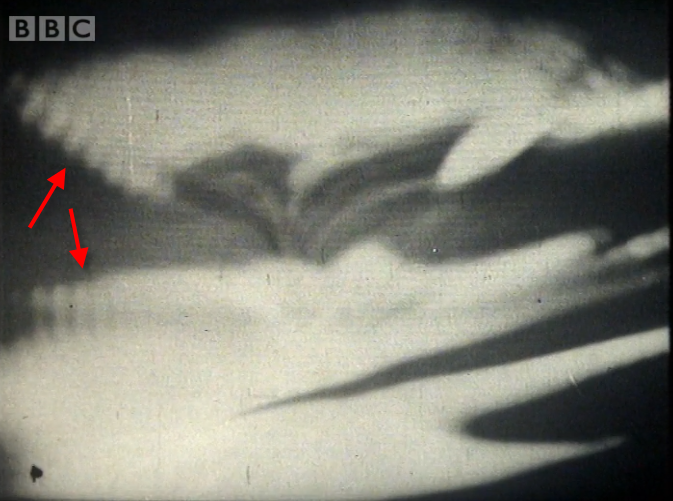Mike Jordan
Just opened by Ravensbourne College https://www.ravensbourne.ac.uk/bbc-motion-graphics-archive BBC Motion Graphic Archive
Lots of memories to look at.
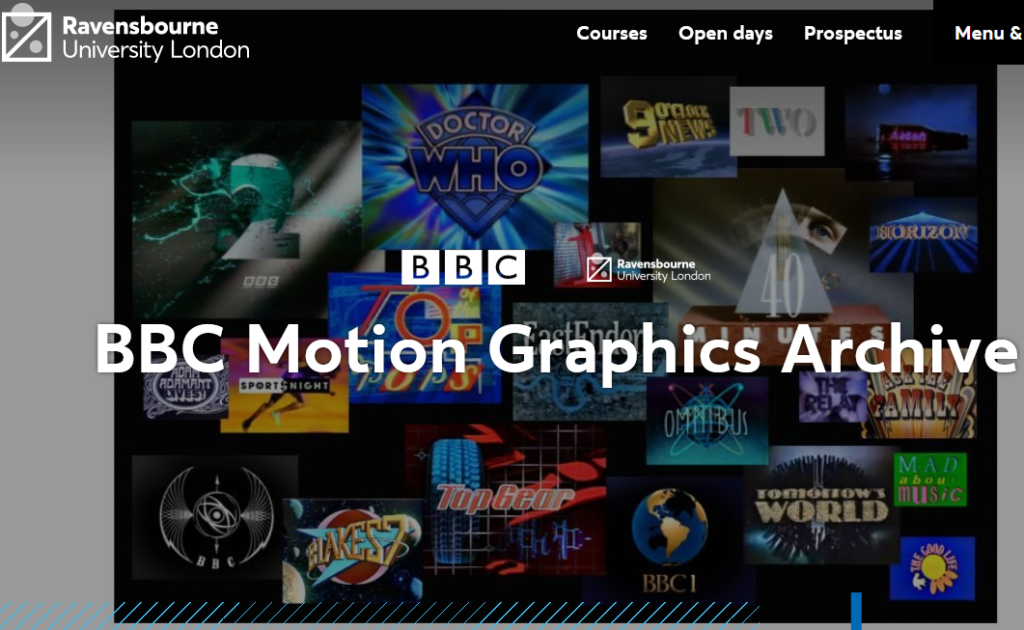
Doug Puddifoot
Great find. The first one I came to was the original “Doctor Who”. I worked on an experimental session at Lime Grove when that was created. It was a normal camera-monitor video howl round, but camera scans were reversed horizontally to get the symmetry. Then the caption was superimposed and also added to the monitor feed, but faded from the howl round as the zoom continued. At the same session, sound created the Dalek voice using, I think, a ring modulator.
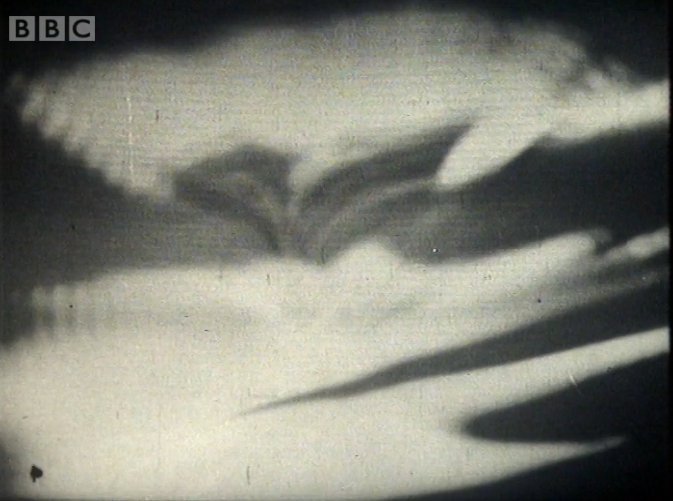
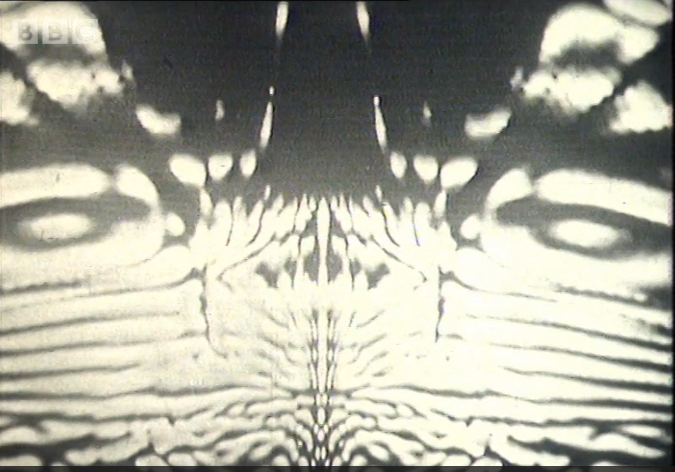
Dave Plowman
There has been discussion about this on a Facebook group.
I remember working on the pilot, in Riverside 1, while on Crew 13 – which was still sort of a training crew at that time. The same pilot was also made in another studio about the same time. I’m told I’m wrong. Yet the memories are there – including discussing it in the pub afterwards and the general view the prog would never make it to air.
I do remember ‘our’ version was never used. The other one was.
It’s possible it was some form of training or exercise, of course. Possibly to do with video FX or whatever. But very unlikely just to be used for training, given the whole cast being used and so soon after the other pilot.
Anyone from the early days of Crew 13 remember?
Anyone have a crew list from those times? Jog my memory just who was on Crew 13 then? Although it might well still have been known as the training crew. Pete Granger became the Senior Cameraman about that time.
I can’t remember when crew 13 [the Training crew] became a ‘proper’ crew. I joined it after the TO course. In those days you did a spell at the studios before the TO course – mine was with Crew 5. For quite a while as that embryonic crew, it was at Riverside – which wasn’t used for any real productions, until after, if I recall correctly, it had new cameras and converted to 625. We also had a ‘permanent’ Sound Supervisor – Alan Edmunds, who’d joined from radio.
I’ve no doubt the “Dr Who” was some form of training or whatever. It may not even have been recorded on tape, but telerecord only. But very unlikely they got the sets and cast for something which was only staff training.
Of course the time would have been late 1963.
Hugh Sheppard
Over the years, I’ve learned that what is remembered is what one last remembered, which may not always be quite the same as recalling the original event.
But my own revisited memory is of being the cameraman for Norman Taylor on a 12 x 9 “Dr. Who” caption as he lit matches in front of it to provoke a howl round. Graphics designer Bernard Lodge was the third person present on the floor of an otherwise bare TC5. Someone else upstairs cued the recordings of several very similar sequences, possibly with audio content, but I’m less sure of that. I do recall Bernard and Norman being delighted, and that one such sequence found its way to the opening titles of first episode of the first series of “Dr. Who” – and then many more.
Who would now be able to corroborate that may be another matter!
David Brunt
That matches the surviving paper trail which confirms:
———————————————————————————-
Sat 31-08-1963
Studio Five Television Centre 16:00 – 17:00
Caption inserts for the first episode on 35mm silent film
———————————————————————————-
The earlier sequences were filmed at Ealing on Tue 20-08-1963.
Chris Glass
Mis remembered?
I also worked on “Dr Who” howl round with a camera pointed at a monitor slightly tilted to induce a suitable swirl and fine tweeking of feeds from B bank mix
Perfect on rehearsal, not so good on recording. TC3, I thought ! The odd thing is that looking at my 1963 diary I have no record of working on “Dr Who” that year – I was busy doing “Marriage Lines”, “Dixon…” and Millicent Martin with crew10, apart from 2 days in R1 on September 3rd and 4th – programme not noted.
Dave Mundy
We had this discussion [about the titles] a long time ago! I remember a session in Studio D where a CPS Emitron camera (well known for its peels!) was pointed at a monitor and moved around to get a suitable ‘video howl’. End of! They may have tried later in different studios which I don’t know about, but I certainly worked on the first few “Dr. Who”s in D, and very smelly it was! Tungsten 4-lights , bare feet, and animal skins don’t make a nice aroma! Needless-to-say, the door to the fire-escape gave us a welcome breath of fresh air!
Pat Heigham
While I was not on the show earlier, I looked after Grams from around 1963. David Brunt’s excellent production guide has most everything about the programme – a real labour of love, thank you, David!
[Here is] a circuit diagram of the Dalek voices set-up (which got circulated with ‘my’ name erased!)
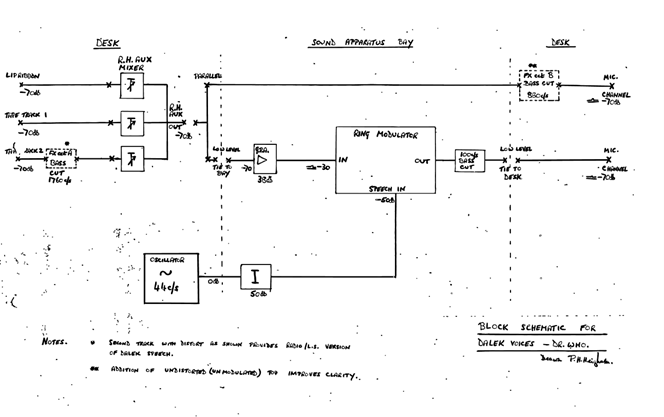
and for a resume of a day’s work on the show see here .
Footnote:
I was recently asked to join in to a ‘bonus’ extra commentary item for the DVD release of “The Ice Warriors”. It was good to link up again with Deborah Watling and Frazer Hines. In the page 170 link, I related a story involving Deborah. Technicians were discouraged from fraternising with artistes – BBC protocol rules! On one occasion, I was having a snack in the Club after a “Dr. Who” rehearsal and Deborah came in with her father, Jack. They asked to share my table, whereupon, she proceeded to play ‘footsie’ with me under the table! Very sadly Debbie passed away in July 2017, from lung cancer.
“Dr. Who”: Great fun to work on and a chunk of my professional life.
David Brunt
Thanks, Pat. Just wait until you see the yearly BBC Studio/Location (Filming & OB) recording book/s, I’ve got slowly coming together. The mid-1970s are filled up nicely for entries at the moment but there’s still a lot of empty spaces in the 1960s left to collate.
Dave Mundy
I did hear that someone managed to get a TR90, in spool mode, to show a Maltese cross picture!
John Howell (Hibou)
At one time there was a capstan sleeve available for a TR90 in the TV Theatre enabling it to run at about 30ips. It managed to record pulse & bar, albeit not locked.
Hugh Sheppard
Thanks to David’s corroboration, at least I now know precisely where I was on an August Saturday 57 years ago!
Here’s the note again, mildly tweaked for the record:
‘…. Over the years, I’ve learned that what is remembered is what one last remembered, which may not always be quite the same as recalling the original event.
But my own revisited memory is of being the cameraman for Norman Taylor on a 12 x 9 ‘Dr. Who’ caption as he lit matches in front of it to provoke a howl round. Graphics designer Bernard Lodge was the third person present on the floor of an otherwise bare TC5. Someone else upstairs cued the recordings of several very similar sequences, possibly with audio content, but I’m less sure of that. I do recall Bernard and Norman being delighted, and that one such sequence found its way to the opening titles of the first episode of Dr. Who – and then many more.
Who would now be able to corroborate that may be another matter! …’
Alan Taylor
There is a modern day effect reminiscent of the video howl round which is sometimes seen.
For large street events or processions, there might be an arrangement where giant video screens are set up at intervals along a long straight road. Think of somewhere like The Mall. If the feed to the screens cuts to a wide angle shot including those screens, you see a ripple effect. The feed to the first screen might be delayed by something like six frames, so the image on that screen changes just a beat after the shot changes. All the other screens also change at the same time, but six frames later, the first screen shows itself changing. Six frames after that, the next screen can be seen displaying that change too and so on.
If there is a long shot showing multiple screens simultaneously, the image on the first screen shows all the other screens progressively rippling to reflect that cut. It might take a second or two for all the screens to change so that they are all shown on that shot. If the shot prominently includes six screens, the ripple will take six times as long as the delay to the first one before all screens are showing the new shot with every screen in shot also showing all the screens in shot.
Just for clarification, I’m not suggesting that each video feed is incrementally delayed. I’m fairly sure that they are fed with similarly timed signals. What I’m talking about is the image of the first big screen changing six frames after the cut and the image of the first screen shown on the second screen takes a further six frames before it’s seen to change on the second screen and so on. Screens seen within screens.
It’s kind of hard to explain in simple language, but it’s something which is frequently seen in those situations.
Vaguely related is the visual representation of the speed of sound seen at events such as Live Aid. You sometimes see a shot from a camera on stage while Queen are performing “We Will Rock You”. Freddie is encouraging the crowd to make rapid overhead rhythmic clapping movements in time with the song. The sound to the PA speakers is progressively delayed to that by the time the people at the back hear the PA feed, it’s the same instant that they would have heard it if the sound naturally travelled that distance. The speed of sound is such that it travels roughly 40 feet per video frame, so there can be an appreciable delay before it reaches people in the cheap seats.
When the crowd clap along with Freddie, they clap in time with what they hear and the shot from the stage shows a distinct ripple as the sound propagates to the back. A visual portrayal of the speed of sound.
Roger Bunce
I’m getting confused now. Are we talking about the pilot episode, the full programme which had to be re-shot because of technical errors? Or are we talking about the recording of the video howl-rounds for the titles? Both before my time. I claim no personal knowledge.
I did read somewhere that video howls had previously be used for the supernatural play “Tobias and the Angel”, and that some of those effects were edited into the Doctor Who titles, in addition to those which were shot specially. Serious historians please correct me.
When I reached Evesham, a couple of years later, and they let us play with the gear, one of the first things I wanted to try was pointing a camera at a monitor to recreate those patterns. We soon discovered that you needed ambient reflections to trigger the howl, and a slight imbalance of shot size to create those long snaking trails. Then by reversing scans you could make patterns that were 2-way or 4-way symmetrical. At one point we managed to create a whirlpool effect. Can’t remember how we did this now, since it would have required rotational symmetry, not just up-down left-right. I thought it was an idea I could sell to ‘Doctor Who’, and even started to dream up a script. But, having watched ‘An Unearthly Child’ again recently, I discovered that they had already used the whirlpool pattern, not in the titles, but when the Tardis was moving through space-time. Someone got there before me!
I was very into dynamic art at the time – Alexander Calder’s mobiles, Marcell Duchamp’s rotoreliefs, etc. – and felt that video howls could create moving patterns that were far more free-form than anything mechanical. So, why has no one ever claimed them as ‘Art’? Same with the music. In theory I was a fan of Musique Concrete, Electronic Music, Sculpture Sonore, etc. and other trendy means of creating music without conventional instruments. But, in practice, they never seemed to come up with a decent tune. (The “Forbidden Planet” music had great atmosphere, but you can’t exactly hum it.) Then, what Ron Grainer, Delia Derbyshire, Dick Mills and the BBC Radiophonic Workshop did with the “Doctor Who” theme absolutely cracked it! Experimental, unconventional, imaginative, unearthly, but with a catchy tune and rhythm that would pass the Old Grey Whistle Test. It should be regarded as a definitive masterpiece of 20th Century avant-guard music – not just a TV theme!
Dave Plowman
I think I know what I’m talking about! It was what I remember being told was the pilot done for a second time at R1. Sometime close to when the original was made by a ‘proper’ crew. With the full set and cast.
I really can’t see this being mounted for pure crew training (far too expensive) – it must have had another purpose.
I could be persuaded I’d imagined it all – except that no-one seems to know anything about this training crew that became Crew 13 either. We who were on it certainly knew it as Crew 13 before it appeared in the normal TODS.
Vernon Dyer
On the subject of video howls, I seem to remember there was such a thing as a Negative Picture Amplifier which – well, did what it said on the tin, and we used that in a trial session. Each frame being the negative of the next added nicely to the howl-round effect.
Alec Bray
I was going through a couple of emails on the Dr. Who titles, and I noticed something that, in all the time I’ve spent looking at these titles, I had never noticed before!
It is quite clear on the Ravensbourne copy of the original Dr. Who titles that there are concentric circles all across the picture – the screen capture does not do it justice!
I don’t suppose this helps in the discussion of the creation of these titles….
